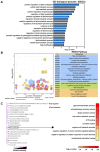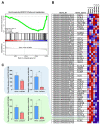Transcriptome Analysis of the Adipose Tissue of Luchuan and Duroc Pigs
- PMID: 36077979
- PMCID: PMC9454924
- DOI: 10.3390/ani12172258
Transcriptome Analysis of the Adipose Tissue of Luchuan and Duroc Pigs
Abstract
Fat deposition is a crucial element in pig production that affects production efficiency, quality and consumer choices. In this study, Duroc pigs, a Western, famous lean pig breed, and Luchuan pigs, a Chinese, native obese pig breed, were used as animal materials. Transcriptome sequencing was used to compare the back adipose tissue of Duroc and Luchuan pigs, to explore the key genes regulating fat deposition. The results showed that 418 genes were highly expressed in the Duroc pig, and 441 genes were highly expressed in the Luchuan pig. In addition, the function enrichment analysis disclosed that the DEGs had been primarily enriched in lipid metabolism, storage and transport pathways. Furthermore, significant differences in the metabolic pathways of alpha-linolenic acid, linoleic acid and arachidonic acid explained the differences in the flavor of the two kinds of pork. Finally, the gene set enrichment analysis (GSEA) exposed that the difference in fat deposition between Duroc and Luchuan pigs may be due to the differential regulation of the metabolism pathway of fatty acid. Therefore, this study described the differential expression transcriptional map of adipose tissue of Duroc pig and Luchuan pig, identified the functional genes regulating pig fat deposition, and provided new hypotheses and references for further study of fat development.
Keywords: Duroc; Luchuan; fat deposition; lipid metabolism; meat quality; transcriptome.
Conflict of interest statement
The authors declare no conflict of interest.
Figures




Similar articles
-
Lipidomic and Transcriptomic Analysis of the Longissimus Muscle of Luchuan and Duroc Pigs.Front Nutr. 2021 May 7;8:667622. doi: 10.3389/fnut.2021.667622. eCollection 2021. Front Nutr. 2021. PMID: 34055857 Free PMC article.
-
Integrative metabolomic and transcriptomic analysis reveals difference in glucose and lipid metabolism in the longissimus muscle of Luchuan and Duroc pigs.Front Genet. 2023 Apr 6;14:1128033. doi: 10.3389/fgene.2023.1128033. eCollection 2023. Front Genet. 2023. PMID: 37091786 Free PMC article.
-
Identification of Differentially Expressed Genes in the Longissimus Dorsi Muscle of Luchuan and Duroc Pigs by Transcriptome Sequencing.Genes (Basel). 2023 Jan 3;14(1):132. doi: 10.3390/genes14010132. Genes (Basel). 2023. PMID: 36672873 Free PMC article.
-
Comparative analysis of translatomics and transcriptomics in the longissimus dorsi muscle of Luchuan and Duroc pigs.PLoS One. 2025 Mar 18;20(3):e0319399. doi: 10.1371/journal.pone.0319399. eCollection 2025. PLoS One. 2025. PMID: 40100799 Free PMC article.
-
Lipid Deposition and Metabolism in Local and Modern Pig Breeds: A Review.Animals (Basel). 2020 Mar 3;10(3):424. doi: 10.3390/ani10030424. Animals (Basel). 2020. PMID: 32138208 Free PMC article. Review.
Cited by
-
Identification of the putative regulatory regions and candidate genes associated with backfat thickness and intramuscular fat content traits in Xiang pigs.BMC Genomics. 2025 Aug 7;26(1):733. doi: 10.1186/s12864-025-11860-y. BMC Genomics. 2025. PMID: 40775679 Free PMC article.
-
Microbial and Metabolic Profiling of Obese and Lean Luchuan Pigs: Implications for Phenotypic Divergence.Animals (Basel). 2024 Jul 19;14(14):2111. doi: 10.3390/ani14142111. Animals (Basel). 2024. PMID: 39061573 Free PMC article.
-
Integrative analysis of the ovarian metabolome and transcriptome of the Yaoshan chicken and its improved hybrids.Front Genet. 2024 Jul 8;15:1416283. doi: 10.3389/fgene.2024.1416283. eCollection 2024. Front Genet. 2024. PMID: 39040995 Free PMC article.
-
Transcriptome analysis of adipose tissue and muscle of Laiwu and Duroc pigs.Anim Nutr. 2024 Apr 13;17:134-143. doi: 10.1016/j.aninu.2023.12.012. eCollection 2024 Jun. Anim Nutr. 2024. PMID: 38766520 Free PMC article.
-
Effect of Fatty Acids on Backfat Quality in Beijing Black Pigs.Foods. 2024 Dec 5;13(23):3927. doi: 10.3390/foods13233927. Foods. 2024. PMID: 39682999 Free PMC article.
References
Grants and funding
- 2019GXNSFDA245029/Natural Science Foundation of Guangxi Province
- 2020GXNSFFA297008/Guangxi Science Foundation for Distinguished Young Scholars
- SKLCUSA-a202006/Guangxi Hundred-Talent Program, State Key Laboratory for Conservation and Utilization of Subtropical Agro- bioresources
- 202110593142/Guangxi Zhuang Autonomous Region level college students entrepreneurship and innovation training program
LinkOut - more resources
Full Text Sources

